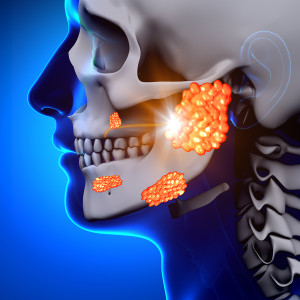One of the most common viral infections of the parotid glands is mumps.
The parotid glands along with the submandibular glands are the main salivary glands. The illness is also known under the name of “endemic parotitis”. It is caused by the mumps virus, a paramyxovirus, and affects mainly the age group of 5 to10 year olds. It is transmitted via droplets and enters through the mouth. The virus can be isolated as long as the parotid glands are swollen, which is up to 9 days.
Signs and Symptoms
The incubation time is 2 to 3 weeks. Next is a fever with a sudden swelling first of the one parotid gland and 1 or 2 days later of the other parotid gland. During the height of the painful parotid gland swelling the fever can be up to 103 to 104 °F (=39.5 to 40°C). There is usually a lot of swelling of the skin over the parotid gland making it look “shiny”. It is extremely painful to touch. The physician will see the swelling and redness of the opening of the main parotid duct inside the cheek.
Diagnostic Tests
Blood tests show a low white blood count. An elevated amylase is often present. An acute and recovery serum can be sent to the lab for confirmation of a mumps titer, which will show an increase due to the mumps virus, but this is rarely done. Similarly, if it is important, direct mumps virus tests can be done in virology labs from throat swabs or cerebrospinal fluid when meningoencephalitis has complicated the course.
Complications
Mumps mostly has a harmless course, but in 1 in 5000 cases of mumps there is a more severe encephalitis that can develop. This can even happen in about 30% of mumps cases where the parotid gland does not get infected (= called CNS mumps).
These cases usually have a better outcome than measles encephalitis. But some cases end up with permanent one-sided hearing loss, gait problems or facial paralysis on one side of the face. Another complication in males is orchitis, which is a viral infection of one of the testicles. This happens largely in boys after puberty and often leads to testicular atrophy. As mostly only one side gets affected, this does not lead to sterility, but in the few cases where orchitis affects both sides, sterility or significantly reduced sperm counts can result. Pancreatitis is another complication. This would usually happen at the end of the first week and becomes apparent because of sudden vomiting, nausea, abdominal bloating and pain. Patients recover within one week without problems (Ref. 7, p. 2325).
Treatment
Treatment is symptomatic. There is no specific therapy available. Patients should be isolated and kept from unimmunized persons for the time that the parotid glands are swollen. Pancreatitis cases may need a brief hospital admission for intravenous fluids. CNS mumps cases need hospital admission, if they become comatose. Fortunately these severe cases are not too common.
Prophylaxis
The vaccine for mumps is a safe, highly effective vaccine. Usually only one vaccination needs to be given around age 12 to 15 months. To make it 100% effective, a second dose is recommended to be given on grade school entry. Here is the official CDC recommendation recommending the MMR vaccine.
References
1. The Merck Manual, 7th edition, by M. H. Beers et al., Whitehouse Station, N.J., 1999. Chapter 84.
2. Noble: Textbook of Primary Care Medicine, 3rd ed.,2001, Mosby Inc.
3. The Merck Manual, 7th edition, by M. H. Beers et al., Whitehouse Station, N.J., 1999. Chapter 85.
4. Rakel: Conn’s Current Therapy 2001, 53rd ed.,2001, W. B. Saunders Company
5. Goldman: Cecil Textbook of Medicine, 21st ed.,2000, W. B. Saunders Company
6. Mandell: Principles and Practice of Infectious Diseases, 5th ed.,2000, Churchill Livingstone, Inc.
7. The Merck Manual, 7th edition, by M. H. Beers et al., Whitehouse Station, N.J., 1999. Chapter 265.
8. MF Williams: Otolaryngol Clin North Am; Oct1999; 32(5): 819-834.
9. The Merck Manual, 7th edition, by M. H. Beers et al., Whitehouse Station, N.J., 1999. Chapter 106.
10. Ferri: Ferri’s Clinical Advisor: Instant Diagnosis and Treatment, 2004 ed., Copyright © 2004 Mosby, Inc.
11. Rakel: Conn’s Current Therapy 2004, 56th ed., Copyright © 2004 Elsevier







